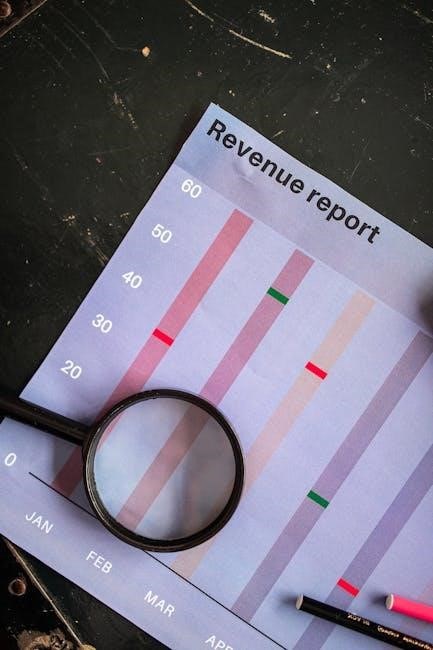Investigation Report Template PDF: A Comprehensive Guide
Investigation Report Template PDF: A Comprehensive Guide
Investigation report templates in PDF format offer a structured approach to documenting findings, ensuring objectivity and accuracy for effective problem-solving and transparency.
Investigation reports are crucial documents used across various sectors to thoroughly examine incidents, accidents, or allegations. These reports aim to uncover the facts, analyze the situation, and provide actionable recommendations. Whether it’s a workplace incident, a safety breach, or a compliance issue, a well-structured investigation report is essential for understanding the root causes and preventing future occurrences.
The primary goal is to present a clear, concise, and objective account of the investigation process, findings, and conclusions. By following a standardized template, investigators can ensure consistency and completeness in their reporting. This introduction sets the stage for a deeper dive into the key components and best practices for creating effective investigation reports.

Understanding the Purpose and Scope
Understanding the purpose and scope of an investigation report is crucial for defining objectives, identifying report types, and ensuring a focused, effective investigation and analysis of relevant information.

Defining the Objectives of an Investigation Report
Defining the objectives of an investigation report involves establishing clear goals. This includes determining the facts, identifying root causes, and documenting evidence thoroughly. The aim is to maintain transparency. A well-defined objective ensures the investigation remains focused and efficient. It also aids in developing actionable recommendations. These recommendations help prevent future incidents. Objectives should align with organizational policies. They should address the specific concerns raised. This clarity guides the investigation process. It supports the creation of a comprehensive and reliable report. The report should lead to informed decision-making and effective problem-solving.
Identifying Different Types of Investigation Reports
Identifying various types of investigation reports is crucial for appropriate documentation. Common types include HR investigations, focusing on workplace issues. Accident reports document incidents to prevent recurrence. Audit reports assess compliance and financial accuracy. Workplace investigation reports tackle misconduct or policy violations. Fire investigation reports analyze fire incidents. Crime reports detail criminal activities. Each type requires a specific format and focus. This ensures relevant information is captured effectively. Selecting the right type streamlines the investigation process. It ensures comprehensive and targeted reporting. Tailoring the report to the incident enhances clarity and aids in problem-solving. The type guides the report’s structure and content.

Key Components of an Investigation Report Template
Key components of an investigation report template include an executive summary, methodology, findings, and actionable insights, ensuring a structured and comprehensive presentation of evidence and recommendations;
Executive Summary: A Concise Overview
The executive summary serves as a critical component of any investigation report, providing a high-level overview of the entire investigation. It encapsulates the purpose, scope, methodology, key findings, and ultimate conclusions or recommendations derived from the investigative process. This section aims to present a condensed yet comprehensive snapshot, enabling readers to quickly grasp the essence of the investigation without delving into extensive details. It’s designed for stakeholders who require a swift understanding of the matter, facilitating informed decision-making based on the report’s most salient points. A well-crafted executive summary ensures clarity and efficiency in conveying crucial information.
Methodology: The Investigation Process
The methodology section meticulously outlines the steps taken during the investigation process. It details the specific procedures, techniques, and tools employed to gather and analyze relevant information. This section should clearly articulate how evidence was collected, including interviews conducted, documents reviewed, and data analyzed. Transparency is key, ensuring that readers understand the rationale behind each step and can assess the validity of the investigation. It should specify how the investigation team approached the problem, the sources they consulted, and any limitations encountered. By providing a comprehensive account of the methodology, the report establishes credibility and supports the findings.
Findings: Presenting the Evidence
The findings section serves as the core of the investigation report, objectively presenting the evidence gathered during the investigation process. It should meticulously detail all relevant facts, data, and observations, ensuring that the information is organized logically and presented without bias. Each piece of evidence should be clearly described and its source identified, whether it be witness statements, documents, or physical evidence. The findings should be directly linked to the methodology employed, demonstrating how the evidence was obtained. This section avoids drawing conclusions or offering opinions, focusing solely on the factual information uncovered during the investigation.
and Recommendations: Actionable Insights
The conclusion synthesizes the findings, providing a reasoned judgment based on the evidence presented. It clearly states whether the allegations or issues under investigation were substantiated, unsubstantiated, or inconclusive. Recommendations, derived directly from the conclusion, offer actionable steps to address any identified problems or prevent future occurrences. These recommendations should be specific, measurable, achievable, relevant, and time-bound (SMART), providing a clear roadmap for implementation. This section bridges the gap between the investigation’s findings and practical solutions, ensuring the report culminates in tangible improvements and contributes to organizational learning and development.

Utilizing PDF Templates for Efficiency
PDF templates offer a streamlined, consistent approach to investigation reports, ensuring standardized formatting, easier distribution, and enhanced data security, ultimately boosting efficiency and maintaining report integrity.

Advantages of Using PDF Templates
PDF templates provide a standardized format for investigation reports, ensuring consistency across different cases and investigators. This uniformity simplifies review processes and enhances overall clarity. The templates help maintain accuracy by providing predefined fields and structures, reducing the risk of omissions or errors.
They also save time by automating the report creation process, allowing investigators to focus on gathering and analyzing data. PDF format ensures that reports are easily shareable and printable, maintaining their integrity regardless of the recipient’s software. The templates can be customized.
Customizing PDF Templates for Specific Needs
Tailoring PDF templates ensures they precisely address the unique requirements of each investigation. Customization involves modifying fields to capture specific data points relevant to the incident, such as adding sections for witness statements or detailed financial analysis. Organizations can incorporate their branding elements, including logos and color schemes, to maintain a professional and consistent image.
Additionally, customized templates can integrate interactive features like dropdown menus and check boxes to streamline data entry. This adaptability enhances efficiency and accuracy, making the templates more effective for diverse investigation types.

Tips for Writing an Effective Investigation Report
To create an effective investigation report, focus on objectivity, clarity, and conciseness. Ensure accuracy by verifying all information. A well-written report provides actionable insights.
Maintaining Objectivity and Accuracy
Maintaining objectivity and accuracy in an investigation report is crucial for its credibility and effectiveness. Begin by gathering comprehensive evidence from various sources, ensuring all perspectives are considered. Avoid personal opinions or biases that could skew the findings. Verify all information through reliable sources and cross-referencing data.
Document every step of the investigation process meticulously, noting any potential conflicts of interest. Present the facts neutrally, allowing the evidence to speak for itself. Seek input from multiple reviewers to identify potential biases. Prioritize factual accuracy, as this will create the basis for solid conclusions and recommendations.
Ensuring Clarity and Conciseness
To ensure clarity and conciseness in an investigation report, use plain language and avoid jargon to enhance readability. Organize the report logically, starting with a clear summary of the purpose and scope. Each section should focus on a specific aspect of the investigation, preventing redundancy.
Employ bullet points and concise paragraphs to present findings efficiently. Visual aids like charts and graphs can simplify complex data. Summarize key evidence and conclusions succinctly, avoiding ambiguity. Review and edit the report to eliminate unnecessary words, ensuring the core message is easily understood by all readers.

Free vs. Paid Investigation Report Templates
Free vs. Paid Investigation Report Templates
When choosing between free and paid investigation report templates, consider the level of customization, features, support, and reliability offered to meet specific needs effectively.
Evaluating the Value of Different Options

Evaluating the Value of Different Options

When evaluating free versus paid investigation report templates, consider the depth of customization needed. Free templates offer basic structures, suitable for simpler cases. Paid options provide advanced features, enhanced security, and dedicated support. Assess if specialized formatting or data analysis tools are necessary. Evaluate the time saved through automated features in paid templates against the cost. Ensure the chosen option aligns with the investigation’s complexity, budget, and long-term reporting needs. Prioritize templates that promote consistency, accuracy, and efficient documentation, ultimately improving the investigation’s credibility and outcomes while being cost-effective.
Where to Find Reliable Templates
Where to Find Reliable Templates
Reliable investigation report templates can be found on reputable websites offering professional resources. Government agencies, legal firms, and HR associations often provide templates tailored to specific investigation types. Software providers specializing in documentation or case management may also offer dependable options. Verify the template’s source and user reviews to ensure its credibility. Check if the template complies with relevant legal standards and industry best practices. Prioritize templates that offer clear instructions, customizable fields, and secure data handling. Always review and adapt the template to fit your organization’s specific needs and policies, ensuring thorough and accurate reporting.
